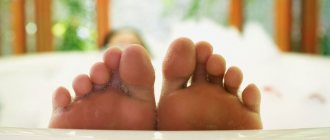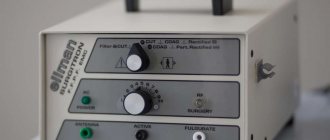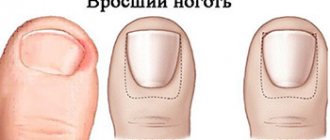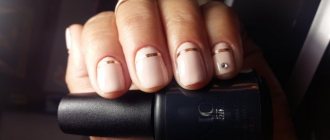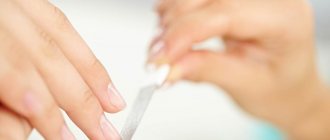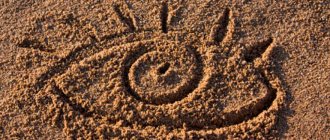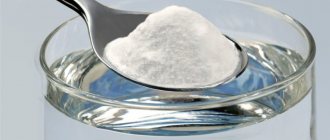Onycholysis is a type of onychodystrophy (pathological change in shape, structure or color), in which the nail separates from the nail bed on the toes or fingers. This defect occurs predominantly in adults, regardless of age. Moreover, in women, more often than in men. The disease spoils the appearance of nails, makes them brittle, brittle, and provokes bacterial and fungal infections.
Causes
In 60% of cases, onycholysis develops after a blow, from injury, or when a nail is pinched. Moreover, even a minor injury is enough that a person will not pay attention to. The second most common cause of nail onycholysis is fungal infection (onychomycosis). The disease is also caused by allergies. For example, when hands come into contact with household chemicals.
Depending on the cause, the nail may be affected only on one finger or on several fingers at the same time.
The risk group includes people who have:
- chronic skin diseases (eczema, psoriasis);
- malnutrition, deficiency of vitamins A, E, group B;
- metabolic disorders;
- predisposition to allergic reactions;
- weakened immunity, including during pregnancy and old age;
- diabetes.
The disease onycholysis often appears in workers in the chemical industry and laboratories, whose hands are constantly in contact with organic solvents and aggressive substances.
Due to the desire for beauty, women face this problem more often than men.
Onycholysis is caused by:
- nail extensions;
- improper performance of manicure or pedicure;
- injury to the cuticle area;
- the use of decorative varnishes, liquids for their removal containing harmful organic solvents;
- gel polish coating.
Almost all women like to do the procedures listed above to make their hands look attractive and well-groomed. But the first thing to remember is safety. Because many of them do not have the most favorable effect on nails. Cause allergic reactions, chemical burns, burns from an ultraviolet lamp.
Often onycholysis occurs on the hands from gel polish or shellac. Why is this happening? The reason is ignoring precautions. When drying under a UV lamp, the nail burns. Therefore, if the master says, take it out, if he bakes, you need to do it. If you tolerate the burning sensation for a couple of minutes, the consequences can be dire. You risk being left not only without a manicure, but also without nails. The burning sensation provokes a burn, a disruption of the connection between the plate and the nail bed. Therefore, you need to take your hands out from under the lamp for a few seconds until the discomfort disappears.
In addition to the above reasons, the disease is caused by long-term use of medications that increase the body's sensitivity to solar radiation. We are talking about antibiotics from the group of penicillin and tetracycline. For example, in the instructions for the drug Doxycycline, the list of adverse reactions states that it can cause photoonycholysis, a change in the color of nails.
The causes of onycholysis on the arms and legs are different. Toenails are less likely to undergo aesthetic manicure procedures, but are more often injured. Most often, detachment of the nail plate occurs on the big toe due to mechanical compression from tight closed shoes, flat feet, improper distribution of the load on the foot, disruption of its biomechanics, and long nail length.
Description of the pathology
Detachment of the nail occurs only at the edge of the plate. It can occur on one of the fingers without spreading to adjacent phalanges. The reason for this is the following phenomena:
- mechanical damage caused by blows, finger bruises;
- fungal infection - spores and mycelium of the fungus spread from the base, gradually penetrating deeper into the bed;
- allergic reactions caused by contact with a cosmetic product, manicure with the application of an artificial nail.
The nail gradually swells. It becomes vulnerable to the action of infectious agents. Not only fungus, but also bacteria can penetrate there. For example, staphylococci, streptococci. In response to this, the effect of local immunity is enhanced. A large number of lymphocytes are produced, which leads to a strong inflammatory response, accompanied by pain, swelling, and redness.
To diagnose the condition, contact a dermatologist, who examines the patient, prescribes a smear, checking for the presence or absence of infection.
If a bacterial lesion forms, in addition to the main symptoms, pus is released. This is a product of the vital activity of pathogenic microflora. Treatment of all conditions is primarily local, with systemic medications required in extreme cases.
Kinds
Depending on the cause, there are several types of disease.
The most common onycholysis is:
- Traumatic. Nails begin to peel off after blows, wounds, burns, splinters, exposure to heat, cold, prolonged exposure to water, or wearing tight shoes. This also includes pathological changes caused by the action of acids, alkalis, solvents, and household chemicals;
- Fungal. It occurs due to the entry and reproduction of fungal infection pathogens in the subungual space. Formed as a secondary complication of onychomycosis;
- Allergic. Onycholysis develops as an allergic reaction due to taking medications with photosensitizing properties, ultraviolet irradiation (photo onycholysis), and contact of the nail plate with harmful chemicals.
Depending on the size of the affected area, onycholysis can be partial, when only a small area of the nail peels off in the form of a strip or semicircle, and complete, when it comes off entirely. Separation of the nail plate can occur from the distal (free) edge or from the lateral ridges (lateral onycholysis).
Care for minor injuries
The patient can often self-treat nail damage at home:
- remove gel polish from damaged nail;
- Gently wash the affected area with fragrance-free soap;
- dressing the wound if there is an open injury;
- immediately after injury - applying cold (ice) for about 20 minutes at a time;
- raise the injured leg above body level;
- application of gentle compression (until hematoma forms);
- taking over-the-counter pain medications as directed.
How to recognize the disease?
With onycholysis, voids form under the fingernail, caused by its inability to grow to the nail bed and air entering the resulting cavity. The main symptom is a change in the color of the nail plate. It becomes cloudy, whitish-gray. In this case, the detachment border most often has uneven edges. Similar symptoms are observed on the legs.
With an infectious cause of the disease, the nail additionally changes its structure, its surface becomes rough, and the color is yellow, brown or green.
With onycholysis, the nail does not grow and becomes brittle and brittle. If an infection gets into the subungual space, a person feels discomfort, pain, and suppuration.
Therapy methods
Pathology is often eliminated using conservative methods. It is important to promptly stop further nail detachment in order to preserve the base. Data on treatment methods are presented in the table.
| Treatment method | Description | Drugs |
| Correction of the gastrointestinal tract | They use medications that saturate the body with useful substances. It enhances metabolism, the condition of hair, nails, bones | Vitamins, minerals |
| Trimming a section of the nail | The method is acceptable after injury. Additionally, a disinfectant is used to prevent infection. | Chlorhexidine, Furacilin |
| Surgical procedure | A large area of the nail is removed, and the entire plate can be removed. Then treated with antibiotics | Erythromycin, Tetracycline |
| Antimycotic agents | Elimination of spores and mycelium of fungi. You can use a complex action product that additionally reduces inflammation | Candide, mycozoral, Mycoseptin, Triderm |
| Antibacterial ointments | Act bactericidal and bacteriostatic, preventing the risk of relapse of infection | Tetracycline, Streptomycin Levomekol, Baneocin |
If drug therapy is started in a timely manner, complications should not arise. It is important to preserve the base of the nail. Then the prognosis will be favorable, the plate will again become integral and adhere to the soft tissues.
Characteristics of antibacterial ointments
The drugs are used only in cases of proven bacterial infection. Otherwise, resistance of microorganisms may develop. The medicine is applied in a thin layer, you can bandage it.
- Tetracycline ointment
. It is based on tetracycline. The drug destroys gram-positive and gram-negative microorganisms. Some strains have resistance to the active substance. The medicine is indicated to eliminate purulent infection, furunculosis, infectious eczema. The only contraindication is children under 11 years of age. - Erythromycin ointment
. The product is based on Erythromycin. This is an antibiotic from the macrolide group, which has activity against gram-positive bacteria and some gram-negative rods. The cream is indicated for chronic diseases and infectious wounds. - Levomekol
. A combined product consisting of 2 antiseptics. Eliminates pus and necrotic masses, quickly destroys infection. Contraindicated in children under 1 year of age with individual intolerance.
It is important to remember that all antibacterial drugs can only be used for a short course, no more than 7-10 days. Otherwise, superinfection and bacterial resistance may develop. Sometimes doctors suggest removing the nail plate with additional application of an antibiotic after the procedure.
Antimycotics that destroy fungus
Systemic antimycotic agents have a detrimental effect on the liver, destroying some hepatocytes. Therefore, doctors prescribe only local drugs to prevent the development of a large number of side effects. Using the following types of ointments and creams.
- Candide
. Clotrimazole-based ointment with antifungal action. It is carried out due to the destruction of the membrane and the destruction of the internal contents of the cell. The drug is indicated for fungal skin infections, mycoses, and lichen. There are few side effects, only allergic reactions are possible. - Mycozoral
. It is based on ketoconazole. This is a synthetic substance that has a fungicidal effect. It is used for dermatomycosis, athlete's foot, lichen, seborrheic dermatitis. Rarely causes allergies. Contraindicated in cases of violation of the integrity of the skin. - Triderm
. A combination drug based on betamethasone, gentamicin, clotrimazole. The antimycotic ensures the destruction of fungi. Hormones suppress inflammatory reactions, reduce pain, swelling, and redness. An antibiotic clears up the infection.
Antifungal medications can be used over a longer course than antibiotics. But their use can also lead to addiction. Therefore, it is recommended to apply drugs only as prescribed by a doctor, for a limited course.
Diagnostics
If you suspect detachment of the nail plate, you should visit a specialist (podiatrist, dermatologist). To confirm the diagnosis and find out the cause of onycholysis, a fungal test is performed.
Based on external signs, it can be confused with onychomycosis, psoriasis, lichen planus and other types of onychodystrophy. Therefore, differential diagnosis is needed. A fungal infection is indicated by a yellow, brown or green color of the nail, its thickening, an unpleasant odor, and itching of the skin around it.
Many who have encountered onycholysis are interested in whether it is contagious? It is not contagious in itself. But often its cause is a fungal infection, which is easily transmitted from one person to another through contact and household contact.
How to treat fungus?
Treatment of nail fungus involves the use of antibacterial drugs as prescribed by a doctor. In some particularly advanced cases, the doctor may prescribe a course of pills and injections. If more than half of the nail has peeled off, surgery is prescribed to remove it. It is necessary to treat the finger for fungus before the new nail plate grows, otherwise the fresh nail will also be infected.
In general, the entire therapeutic complex will include the following activities:
- use of antifungal and antibacterial ointments;
- antiseptic lotions;
- foot baths with a decoction of medicinal herbs;
- taking vitamins high in calcium and iron to strengthen the nail plate.
In most cases, the prognosis is favorable. However, the cosmetic defect may not be completely eliminated.
Treatment
Treatment of the disease is long-term, taking up to 5–6 months. Selected individually, taking into account the reason. For help, you need to contact a dermatologist, podologist, or mycologist. The larger the area peeled off, the longer the recovery will be.
Treatment for nail onycholysis includes:
- cleaning or removing the exfoliated part of the nail plate;
- fight against fungal infection, if it has been detected;
- protection of the exposed soft tissue area;
- prevention of infectious complications;
- stimulation of nail growth;
- correction of a cosmetic defect.
It is recommended to consult a doctor immediately. The use of folk remedies and methods to treat onycholysis without consultation is fraught with complications. It is very important not to let the problem take its course. The more time is lost, the less likely the nail will grow. When a cavity forms between the nail and the nail bed, the skin becomes hard over time and can no longer adhere to the nail.
The main thing that needs to be done to effectively treat nail onycholysis is to stop the influence of the traumatic factor. If the detachment occurs due to an allergy to washing powder or cleaning agent, you need to change them to others and use thick rubber gloves.
If the cause is infection, measures are necessary to destroy the pathogen. To combat the fungus, varnishes, local ointments, and creams are used. In severe cases, antifungal drugs are added orally. The course of treatment and specific medications are prescribed by the doctor. For bacterial infections, antibiotic ointments are prescribed.
If detachment of the nail plate occurs due to a nail injury, prosthetics with a special medical gel are used to correct the cosmetic defect. It differs from standard gels that are used for extensions. Made from hypoallergenic components, does not cause an allergic reaction or burn. Gel prosthetics for onycholysis helps to close soft tissues, minimize the risk of injury to the nail bed, and prevent infection. Materials for prosthetics contain antifungal and antiseptic additives. But this method can only be used in the absence of infection.
To speed up nail growth, vitamins, iron and calcium supplements are prescribed. Local remedies (oils, cuticle creams) and finger massage are also used to improve blood circulation.
How to provide yourself with first aid, what should you do?
Find out what to do if you receive a mechanical or chemical injury to your nail, it falls off or begins to peel off, from the following instructions:
- Apply a cold compress to the injured area.
- Wrap your finger with an elastic bandage - it is acceptable to slightly tighten it.
- If the nail begins to peel off, you can apply a gauze compress soaked in apple cider vinegar and vegetable oil.
The situation is more complicated if the cause of nail detachment is a fungus. Here you can no longer do without medical consultation. Remember that self-medication is simply dangerous.
Only a specialist can select an effective antifungal drug. If the nail has almost come off, simply steam your feet in a basin with warm water and medicinal herbs so that the plate comes off on its own. A decoction of:
- lemon balm;
- chamomile;
- St. John's wort;
- calendula.
What is nail prosthetics?
What representative of the fair sex does not want to look irresistible, and for this it is necessary to take into account absolutely everything in the image: clothes, shoes, perfume, hair, and even nails. However, many girls cannot boast of the ideal condition of their nail plates. Due to various diseases, lack of vitamins in the body, injuries, unsuccessful manicure or pedicure procedures, their nail condition and appearance can deteriorate significantly.
However, today this is not a problem, since you can even change the shape of the nail plate given to a person by nature. You should never despair, because there is always a way to become more beautiful and gain self-confidence. Nail prosthetics has recently become very popular.
The procedure involves completely replacing a damaged or missing nail plate on the feet or hands, or attaching a prosthetic to the remainder using artificial materials.
When, as a result of certain diseases or injuries, the nail is destroyed (partially or completely), a cosmetic defect may subsequently form. Although it does not pose any danger to life and health, it can cause discomfort, especially when it comes to the fair half of humanity.
Prosthetics allows you to restore a deformed, completely missing or split nail and restore self-confidence. The artificial plate is no different in appearance from the natural one.
However, you should not confuse prosthetics with extensions, which are carried out in beauty salons, since the materials used in the second case (acrylic, gel, etc.) are completely unsuitable for restoration in the first way.
For manicure, masters usually use non-plastic and very dense raw materials. Therefore, during loading, damage to both the artificial material itself and the bed under the nail is possible. For prosthetics, products that have plasticity are used.
Thanks to the presence of necessary substances in large quantities, the prosthesis is durable and flexible, like a natural nail. In addition, the presence of certain components in them helps to avoid the formation of bacteria and fungus.
The result of prosthetics is as follows:
- Nails acquire a natural and attractive appearance.
- Injuries to the fingertips are eliminated, and the load on them is also reduced.
- The feeling of support is restored.
- The fingers regain their former sensitivity (with prosthetics on the lower extremities).
Prevention
To protect yourself from a disease such as onycholysis, you need to follow simple recommendations. These include:
- Wear shoes made from natural materials.
- Change socks every day.
- Do not wear tight and uncomfortable shoes.
- Dry your feet thoroughly after contact with water.
- Protect your nails from injury.
- Eat properly.
- Do not take antibiotics unless prescribed by a specialist.
- Treat chronic diseases.
- Carefully follow the rules of hygiene.
To determine what caused the disease, you need to visit a specialist and get tested. Self-medication for this disease can only aggravate the situation and cause complete rejection of the nail plate.
Is it possible to grow a nail?
If the nail detachment is small, caused by fungal, bacterial, or allergic damage, it can be grown back quickly. But for this it is recommended to adhere to all doctor’s prescriptions. It is enough to choose a cream with the desired effects, then complete removal of the plate will not be necessary.
Cutting out the nail is indicated for those patients in whom it has separated from the plate by half or more.
When a dermatologist recommends a nail extraction procedure, many patients worry whether the nail will grow back. If you follow all the rules of prevention after the procedure, a new nail will grow. But this time he becomes healthy, since the damaging factor no longer acts.
If the root cause has not been established, nail detachment occurs again. But this time, conservative methods may not help. The plate will need to be removed down to the base. Therefore, it is important to visit a doctor in a timely manner and conduct laboratory and instrumental tests to identify the source of the lesion.
Preparing for prosthetic nails on a toe or hand
- An examination is carried out, during which the condition of the nail, the degree of its damage are assessed, and material for prosthetics is selected.
- Treatment begins with treating the finger with a spray or solution with an antiseptic effect.
- Using sterile instruments, all affected areas of the plate are removed, leaving only healthy and strong tissue. This is done to ensure that the prosthesis fits better.
- The rough layer is removed from the rollers to avoid ingrowth of the natural nail under the artificial one.
- The plate and open bed are re-treated with antiseptic agents. This is necessary in order to destroy bacteria that cause inflammation, as well as remove the fatty layer that interferes with the quality fixation of the prosthesis.
- After completing the above stages, prosthetics are performed, the type of which depends on which of the three types of prosthesis was chosen.
It is not so important what material was used to create the artificial nail. Any of them contains strong antifungal components that help prevent the development of fungal infection under the plate.
